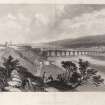Berwick Bridge
Bridge (Period Unassigned)
Site Name Berwick Bridge
Classification Bridge (Period Unassigned)
Canmore ID 292954
Site Number NT95SE 85
NGR NT 99660 52766
Datum OSGB36 - NGR
Permalink http://canmore.org.uk/site/292954
- Council Northumberland
- Parish Berwick-upon-tweed
- Former Region Northumberland
- Former District Berwick-upon-tweed
- Former County Northumberland
NT95SE 99660 52766
For Berwick Bridge over the Berwick Burn, Cockburnspath, see NT76NE 62. (A Cassells, 11 March 2010).
Construction (1610 - 24 October 1634)
Built over a 24 year period.
Project (2007)
This project was undertaken to input site information listed in 'Civil engineering heritage: Scotland - Lowlands and Borders' by R Paxton and J Shipway, 2007.
Publication Account (2007)
There are records of the destruction of several early wooden bridges over the Tweed at or near this site either by man or nature from 1198 onwards. On 15 February 1607 ice, carried by a strong current, demolished the last timber bridge and a grant was made from the Privy Council to build a new bridge of stone. The bridge, one of Britain’s largest and more important, is 1164 ft long of 15 arches, and 17 ft wide between parapets.
It was begun in 1610 and took 24 years to complete. The master mason at first was James Burrell who was granted an allowance of 2/6d per day for directing and overseeing. By 1620, seven arches were completed and a contract was entered into with Lancelot, Branxton & Burrell to complete the work within two years. There was serious flood damage in 1621, made worse by the collapse of the old timber bridge, and the contract was cancelled. Work recommenced in 1622 under day labour and eventually the bridge was completed on 24 October 1634 at a total cost of £14 960 1s 6d. The nearly semicircular, slightly pointed, arches vary in span, the largest being 74 ft. The bridge is asymmetrical in elevation being higher at the Berwick end. It was built to a high standard with flourishes of ornamentation on some elevations. The piers are founded on oak piles ‘properly bound with iron’ and each pier is protected against scour by starlings ‘or surrounds’ 3 ft to 6 ft in width. The bridge now carries local traffic.
R Paxton and J Shipway 2007
Reproduced from 'Civil Engineering heritage: Scotland - Lowlands and Borders' with kind permission of Thomas Telford Publishers.




























































